Tourist Places in GangtokGangtok is the best hilly location in India for those seeking eye-pleasing scenery. This gorgeous city is also the capital of one of the northeast states, that is, Sikkim of India. It is very alluring, gloriously raucous, and covered with the clouded sky. At 1650 meters above sea level, Gangtok offers stunning views of Mt. Kanchenjunga on clear days. In the early 1980s, Gangtok became well-known as a Buddhist spiritual destination. Due to its outstanding natural charm and religious importance, it is currently one of Northeast India's most popular cities. Gangtok is a popular tourist destination thanks to its stunning surroundings, several peaceful monasteries and temples, delightful lakes and rivers, magnificent hiking trails, and towering and beautiful Himalayan mountains. Tourists can't help but fall in love with Gangtok because of the friendly locals, rich history and tradition, fascinating and colorful marketplaces, and wonderful festivals. Gangtok, a picture-perfect city with spectacular scenery nestled in the Eastern Himalayas, has been drawing travelers for centuries and will never lose its allure. Gangtok is the ideal destination for thrill-seekers who want to explore the Himalayan Mountains areas on foot or by horseback. Between March to May, the wild shrubs and the blooming of rhododendrons cover the whole area and fields like carpets of different colors. Gangtok, which words mean "Hilltop," is without a question one of the most attractive mountain towns in India. Gangtok is a vibrant, alive piece of heaven and beautiful artwork by God in the northeast, with urbanization and ethnic identity blending in just the right amounts. In Gangtok, there are numerous picturesque beauties and outlying neighborhoods, such as Tashi viewpoint, Ban Jhakri Falls, Tsomgo Lake, and others. Other than that, there are many recognized religious sites, such as the Do Drul Chorten Rumtek Monastery, that are among the other things to see. In fact, the Teesta river is often regarded as the ideal location for this enjoyable activity of river rafting. Picking just one out of the major tourist spots in Gangtok is difficult because there is plenty to go around. However, here we will present to you the list having the top tourist places that one cannot afford to miss when visiting Gangtok: 1. Nathu La Pass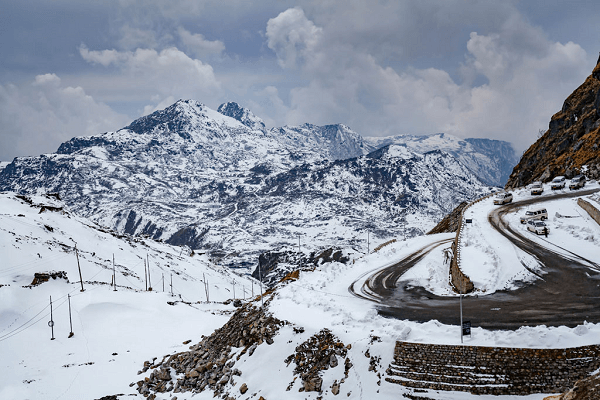
As a sort of mountainous pass in the Himalayan mountains, Nathu la serves as the connection between Sikkim and China. It is among the biggest accessible vehicular highways in the world. With an elevation of 14,450 feet and boundaries with the Indo-Tibetan region, Nathu La is one of the most important crossings from a strategic standpoint. Nathu denotes "listening ears," while La implies "pass." One of the three active trade border crossings between India and China, Nathula is well known for its stunning beauty and lovely surroundings. Nathu La Pass, which was once a part of the old Silk Route connecting Tibet and India, is blessed with scenic natural beauty. Driving through its slick, rocky slopes while ascending to a height of 14,140 feet will be quite the excitement. One must obtain entry permits from the zonal office in order to visit Nathu La because access to this area is limited. The pathway is frequently closed owing to severe snowfall, and winters may not be the best season to come owing to the low temperatures. For much of the year, the temperature stays low there, and in the summer, this becomes a major tourist attraction. This region experiences temperatures are as low as -25 degrees Celsius. If one truly enjoys snow, one can visit Nathu La Pass in the winter while wearing warm wool clothing. On the other hand, even if the summer season here is nearly as cool as the winter season in other regions of the state, it lasts from May to the middle of November with a high temperature of 10 degrees Celsius. In addition to taking pleasure in the pass itself, one can explore the border trade market at Sherathang and have a one-of-a-kind shopping encounter where one can buy items like China clay, raw silk, and even a good quantity of better quality butter and sheep skins, etc. 2. Tsomgo Lake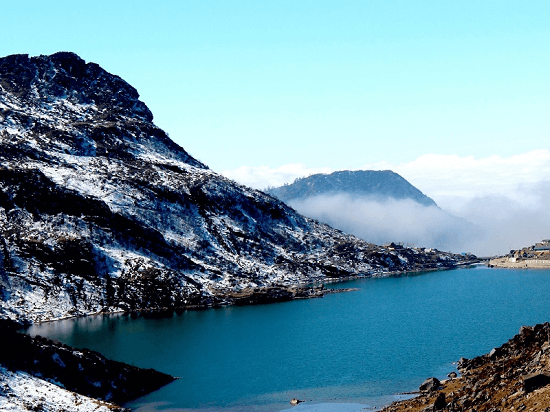
At the astoundingly high height of 12,400 feet above sea level, Tsomgo Lake lies tucked between the Himalayas on the Gangtok-Nathu La highway. This is on every visitor's list for a legitimate reason - its breathtaking natural beauty. It is also called Changu Lake. The lovely grandeur of Tsomgo Lake is sure to captivate anyone as it is encircled by soaring snow-capped mountains and sits amongst a vivid green carpet of alpine trees. The lake is unquestionably a must-see site in Sikkim due to its captivating natural beauty and mythological significance to the natives. Tsomgo Lake is a glacial lake that receives its water from nearby mountains' melting snow. It's beautiful to view the lake's crystal-clear waters reflecting the gorgeous Himalayan peaks. The waters of this glacier lake are renowned for changing color. Throughout the monsoon, the lake seems bright aquamarine, but during the winter, it turns into a translucent layer of ice. The lake's edge gets adorned with thousands of blooming flowers in mid-May, which gives the waters a swirl of vivid colors as summer draws near. The words "Tso" and "Mgo" in the Bhutia language, which together roughly translates to "source of the water," have great religious and cultural relevance to the Bhutia population. Changu Lake, regarded as a holy lake by the Sikkimese, is linked to numerous beliefs and tales. They claim that Buddhist monks once studied lake color analysis to predict the future. 3. Rumtek Monastery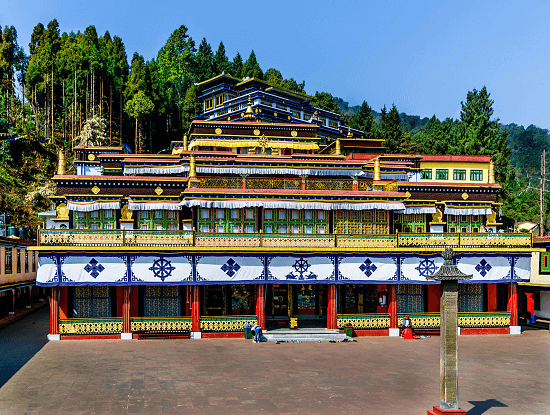
One of Sikkim's biggest and most important monasteries, the Rumtek Monastery is set atop a hill 23 kilometers from Gangtok. It relates to the Buddhist Kargyu sect, which got its start in Tibet in the 12th century and was originally known as the Dharma Chakra Center. The three-story monastery is a superb illustration of traditional Tibetan gompa architecture. The monastery is surrounded by lush green mountains, which provide not only a visual pleasure but also a center for spiritual comfort. The entire Gangtok town, which is located just opposite the hill, can be seen in magnificent perspective if one ascends to the roof of the Rumtek Monastery. In addition, the spectacular monastery has some of the best architecture in the entire globe. The three-story monastery is a superb illustration of traditional Tibetan gompa architecture. The magnificent Rumtek Monastery has a lovely shrine temple and a monastery for the monks that was founded with the intention of disseminating Buddhist teachings worldwide. The majestic site is surrounded by a pathway where visitors, pilgrims, and monks can engage in Kora (a circuit round of the monastery). A majestic golden stupa and several other sculptures that belonged to the 16th Karmapa have been conserved at the spectacular Rumtek Monastery. In addition to housing some of the most distinctive religious texts in the world, it also functions as a storage facility for numerous rare objects. A sight to behold is the enormous prayer hall inside the grand monastery, which is embellished with exquisite murals, statues, and thangkhas. 4. Khangchendzonga mountain and Khangchendzonga Biosphere Reserve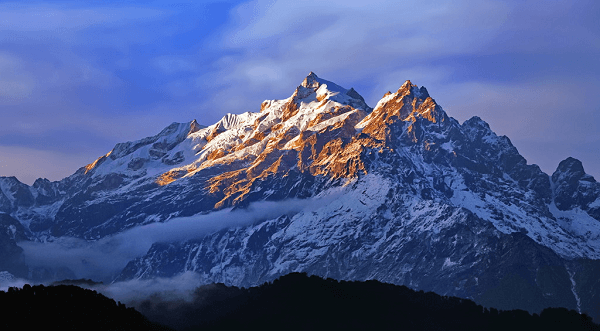
For the greatest vistas of Khangchendzonga, travel to Gangtok. The majestic Kanchenjunga, often spelled Kangchenjunga, is the third-highest peak in the world and among the most beautiful mountains. One of the most significant spots to see in Gangtok, it was originally thought to be the tallest mountain peak in the entire world before Mt. Everest's height was revised. Mount Kanchenjunga, which Nepal, Sikkim, and Tibet surround, was first ascended in 1955 but has since been designated a holy mountain. The Tibetan term Kanchenjunga translates to "The Five Treasures of the High Snow". The treasures stand in for God's five treasuries, which are represented by gold, silver, gems, grain, and sacred texts. There are numerous walking paths in and around Kanchenjunga that will lead visitors through forested landscapes and tranquil lands. Standing at a peak elevation of 8,586 meters, Kangchenjunga Mountain near Darjeeling is the third-highest peak in the world. The peak, also known as Sewa Lungma in the local Limbu tongue, is highly revered in Sikkim's Kirat religion. Four of Kanchenjunga's five peaks may be seen from numerous locations in Darjeeling, and Gangtok, like the peak, may be seen in all its splendor from Tiger Hill. When starting a trek up the mountain from Gangtok, most people use the Goecha La trek in Sikkim as their campsite. The best locations for photography are thought to be Singhik View Point and Tashi Viewpoint. So, take your camera to this location and capture some lifelong moments. Additionally, arrive here before sunrise or sunset to experience the sky in all its grandeur. 5. Khangchendzonga Biosphere Reserve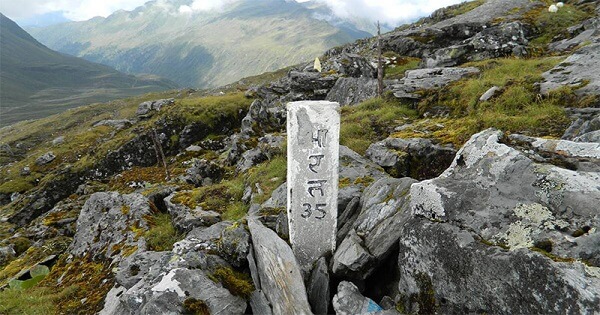
This spectacular natural habitat in Gangtok, one of the top tourist destinations in the city, features a vast variety of normal, endangered, and practically extinct flora and fauna. This biosphere reserve covers roughly 850 square kilometers. It is situated at a high elevation and serves as the habitat for several species, including Himalayan tahrs, Musk deer, and snow leopards. But there's more! One will have a blast with their friends and family because the ticket to the biosphere reserve is only minimally priced. Make sure to bring them along. One shouldn't forget to bring their camera so they can capture the splendor of this location on camera. 6. Ganesh Tok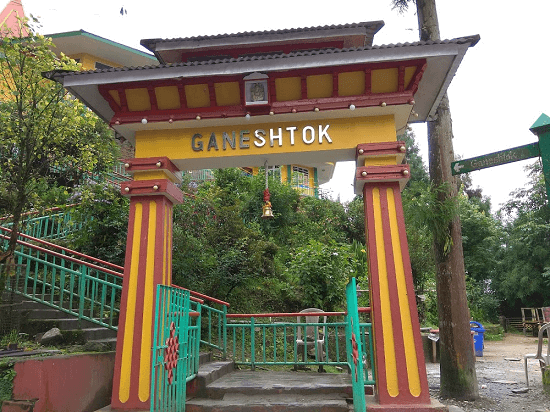
A popular site in Gangtok is the little shrine known as Ganesh Tok. The charming location, perched atop a hill, offers mind-blowing vistas, including a genuine representation of the Kanchenjunga Hill, which is best seen here in the morning. In 1952-1953, while Shri Appa B Pant served as Sikkim's political officer, he constructed it. Given that it is located at the height of 6500 meters, the Ganesh Tok viewpoint offers spectacular views of the Himalayas blanketed in snow. The heavenly location's dreamlike surroundings and soothing atmosphere bring visitors closer to nature. The Ganesh Tok Temple is a small temple. Flags of various colors are strung across the stairs to make them distinctive. Prior to entering the temple, one can wash their hands and store their shoes in a designated area. Furthermore, there is a lounge and balcony right in front of the temple, which makes for a terrific site feature. Ganesh Tok is encircled by picturesque mountains, hills, and landscapes. The area is so congested that worshipers of Lord Ganesha must kneel on all fours. Since it can only hold one person at a time, getting here requires crawling, but the experience one will have here will be priceless. It is unquestionably recommended to visit Ganesh Tok at least once in order to take in its beauty and escape from the mundane daily routine. For all artists and nature enthusiasts, it is the ideal location. Equally stunning are the sunsets from this location. 7. Himalayan Zoological Park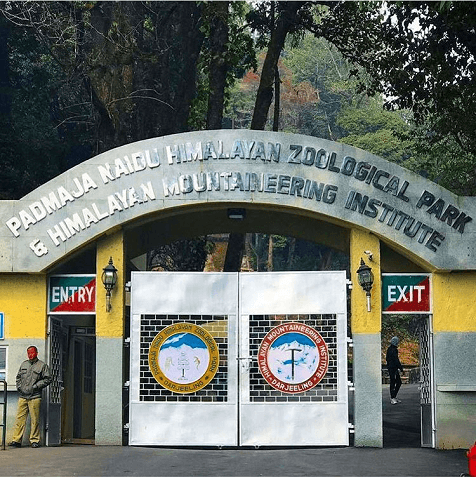
The Himalayan Zoological Park is among Gangtok's top tourist destinations and is nearby. The Himalayan Zoological Park exhibits some of nature's most beautiful gifts to visitors from all across the world who travel to Sikkim to partake in wildlife tourism. This park offers a range of attractions, including a stunning array of flora and fauna. The Himalayan Zoological Park is a destination for all wildlife enthusiasts and is situated near Bulbuley, 3 kilometers from Gangtok. At the height of 1780 meters, this location offers a breathtaking panoramic view of Mt. Kanchenjunga. Himalayan Zoological Park, the first facility of its sort, was founded in 1991 and is located in India's northeast. The park satisfies all standards for a zoo, keeping animals in proper enclosures, protecting them, taming them without upsetting them, and guaranteeing that they exist in their natural habitat. The park, which covers an area of 205 hectares in the hilly terrain, is the place of a wide range of wildlife, such as the snow leopard cat, goral, Himalayan palm civet, Himalayan red panda, Himalayan monal pheasant, crimson-horned pheasant, and Himalayan black bear. With friends and family, one will have an absolute blast there. To protect both themselves and the animals, visitors should keep a respectful distance from the animals and refrain from trying to feed them. 
This is Sikkim's first zoological park, which is maintained by the government of Sikkim's Forests, Environment & Wildlife Management Department. The park is traversed by a 2.5-kilometer road on which one can drive or stroll. If one chooses to walk, one should plan accordingly because it will take a while to get to the habitats. It is therefore advised that one should rent a car for around a half-day and tour the zoo. The zoo has a number of amenities, including a café, a gift store, drinking water stations, restrooms, and a watchtower from which one can enjoy a breathtaking view of the entire landscape. To see a range of species' native habitats and the breathtaking scenic wonders of the area, one should definitely not miss visiting the Himalayan Zoological Park in Gangtok. 8. Harbhajan Singh Memorial Temple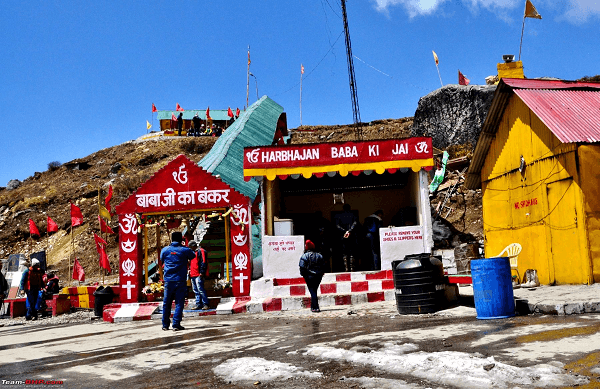
The temple built at Harbhajan Singh's Samadhi is called Baba Mandir, and it is located 64 kilometers away and at an altitude of 4000 meters. It is located on the route that runs between Nathu La and Jelepla Pass. A temple is honoring the sacrificed soldier Harbhajan Singh from the Sino conflict. On the Nathu La pass, Harbhajan Singh sacrificed his life in defense of his nation and his comrades. According to local faith, Baba Harbhajan Singh must be honored by everyone entering the Nathang Valley or traveling through this breathtakingly gorgeous landscape. One would be foolish to believe it to be a typical temple. They will be rewarded for ascending the stairs to the concrete building, which is surrounded by bells on both sides, with the most transcendent samadhi one would have ever experienced. According to legend, Sepoy Harbhajan Singh disappeared while escorting a group of mules from his division in Tukla to Deng Dhukla in East Sikkim 35 years ago. The soldiers initiated a hunt, and after three days, they found his body. Additionally, it is thought that he was the one who directed the soldiers to his corpse. Following that, many of the troop's members claimed that Baba had been appearing to them in dreams and asking that they construct a shrine in remembrance of him. As a result, a shrine was built in his honor and given the name "Baba Harbhajan Singh Temple." Most people think that after donning his uniform, Harbhajan Singh makes his rounds at the shrine every night. He is revered as a saint who protects the lives of border patrol officers. This impression has led to him being regarded by the Indian army as a soldier who has never perished. Harbhajan Singh maintained his rank in accordance with the law till he "retired" a few years ago. The popularity of this shrine among visitors to Gangtok can be attributed to this legend. One may find a big portrait of Harbhajan Singh inside the Baba Mandir, which his followers revere. Visitors leave their water bottles here for a few days and then retrieve them since it is said that drinking this water will fulfill all of their wishes. On one side of the temple, Harbhajan Singh's office has been constructed, along with an eating space and a chamber for him to remain in a while wearing his uniform and shoes. Although the temple is located alongside a road, it is encircled by stunning mountains, providing visitors with a wonderful perspective. Baba Harbhajan Singh Temple is a must-visit because of the urban tales that surround the area. The delightful experience of visiting this temple can be paired with a trip to Nathu La pass. 9. National Institute of Tibetology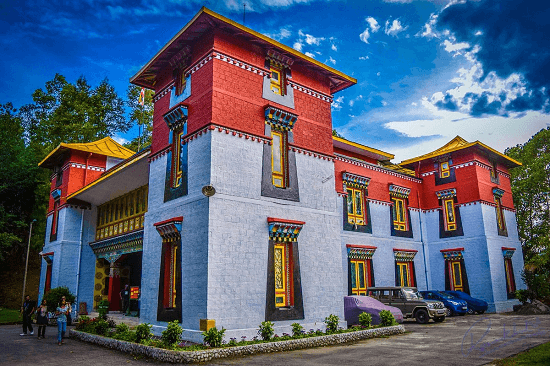
The Namgyal Institute of Tibetology, one of the few of its kind, is a haven for the long-standing Tibetan-Buddhist culture and its origins. The magnificent assortment in the museum and library, which are the major draws here, reflect the commitment with which NIT preserves the illustrious heritage of the nation, the religion, and its priceless culture. As significant as it is for those who study Asian culture and Buddhism, its tranquil, soothing appeal also makes it a haven for travelers, especially for the sporadic history aficionado. A palace that reflects traditional Tibetan architecture, the Namgyal Institute of Technology provides insights into Buddhist culture. Despite originally serving as a center for the study and investigation of Tibetan and Buddhist culture, Gangtok's Namgyal Institute is now a popular tourist destination. It endorses the research of Tibetan history, language, philosophy, art, and all of its related fields, as well as its discovery and preservation. Namgyal Institute of Tibetology, whose foundation stone was set by the great Dalai Lama personally, is a forerunner in the protection and advancement of Tibetan art and literature. The exterior stands impressively with its tall golden towers, appealing and significant murals, and vibrant frescoes. It was constructed in the Tibetan architectural style within a lush green natural setting. The authentic teachings of Lord Buddha are among the roughly 60,000 books in the Institute's library. The halls of this Institute also house a sizable picture of Manjushri, the bodhisattva of wisdom and knowledge. The beautiful and meticulously preserved items in the library and museum, including the statues, manuscripts, works of art, rare books, encyclopedias, relics, and remains, reflect a culturally rich history and, thanks to NIT, a future filled with academic success. Here, photography is not permitted inside, but one is free to disconnect from technology and observe everything via their senses. 10. Seven Sisters Waterfalls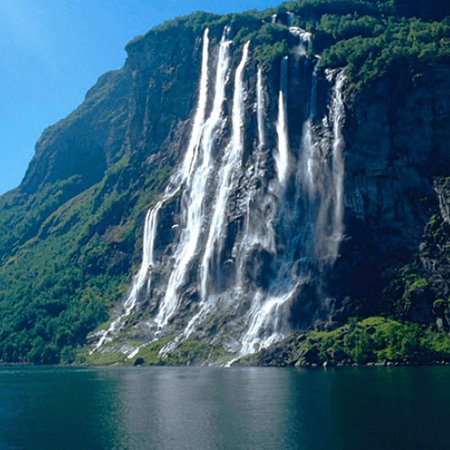
The Seven Sisters waterfalls, one of Gangtok's most breathtaking and impressive sights, must be seen when one is visiting Gangtok. Seven Sisters Waterfalls, which live up to its name, is made up of seven separate waterfalls that are pleasantly situated next to one another on a broad, craggy cliff that appears distinctive from a distance. These seven streams combine to create a tremendous waterfall that captivates the attention of all onlookers. On the Gangtok-Lachung Highway, this spectacular waterfall is located 32 kilometers from Gangtok. After the rain, it springs to life and presents a mesmerizing vista, making it even more stunning. The gushing water creates a thunderous sound as it cascades down the limestone cliffs and through the lush greenery. The sight of the sun setting entices tourists to engage in an extended photographic session. The Seven Sisters Waterfalls have become the ideal picnic location to spend time with family and friends, thanks to the Tourist and Civil Aviation Department's construction of a waiting shelter and a cafe for visitors to revitalize themselves and take pictures of this natural beauty. There is a ropeway close to the waterfall is a fantastic spot to get a close-up view of the falls. The fascinating Seven Sisters waterfall received its name partly due to the fact that it cascades in seven phases, only four of which are visible to visitors. The remainder of it drops much further and is concealed by the rocks, making it impossible to see. One of the most popular and photographed waterfalls in the area, the sight of the flowing water set against green mountains in the background is enough to captivate tourists. Photographers, nature enthusiasts, and picnickers all adore this picturesque location. Here, a small footbridge has been built over the stream to provide visitors with a better perspective and a stop for taking pictures. The greatest time to explore the Seven Sisters Waterfalls is during a rainy season or when the snow has melted because this is when the waterfall re-emerges and is at its most beautiful. If someone is considering visiting Gangtok, they should make sure to add this destination to their must-visit locations list because of its splendor and location. 11. MG Road or MG Marg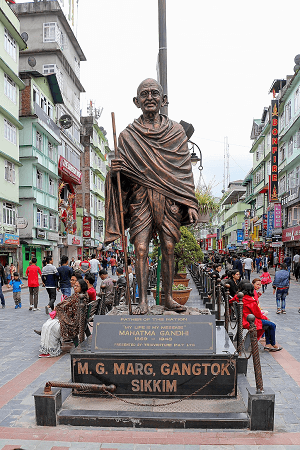
While visiting the city, one must make sure to visit MG Marg, the most well-known tourist attraction in Gangtok. The core of Gangtok and its most active area is MG Road. With several stores, eateries, and hotels lining both sides, it serves as the state capital's prime shopping district. The perfect place for tourists to shop is on MG Road, a large open mall or boulevard area that is described as the heart of the city. The best of Gangtok's tourism culture is incorporated into this lovely location, which showcases it to guests in vibrant exhibits. Visitors can enjoy the unique vibe of this place by simply sitting on one of the seats or taking a casual walk through this area. The cleanliness of this roughly one-kilometer length of road is the immediate thing that one observes. The words "Welcome to M.G. Marg, Spit, and Litter Free Zone" are posted on billboards all across the place. There are no vehicles, smoke, or trash anywhere in the vicinity. Vehicles are not permitted in this zone; it is a pedestrian-only area. In accordance with the government's green policy, the buildings in Gangtok on each side of MG Road are painted green. This pedestrian-only area is a nice place to spend one's evenings in Gangtok, given that it is free of trash and pollution. The Bhutia Chieftain Khye Bumsa, the Lepcha leader Thetong Tek, and his wife Ngo Kong ngol are all depicted on the Statue of Unity, which stands over MG Road. This statue encourages unity, love, and peace. A large statue of Mahatma Gandhi is located around halfway across. The Victorian lighting and different benches scattered along the path are additional attractive features. The MG Road in Gangtok is a popular destination in this serene hill town because it looks lovely after dark when the lights are on. M.G. Marg, which is regarded as Gangtok's town center and is home to several amazing eateries, eating outlets, and cafes. Here, one may enjoy delectable food at restaurants like Bakers Cafe or even 9INE Native Cuisine, all of which are located on MG Marg. Tibetan food is one of 9INE Native Cuisine's most well-known specialties. The traditional Sikkimese supper with chicken and mushroom kachi, among other dishes, could be savored here. Delights like Momos and Dimsums can also be found here. It is a must-visit restaurant in Gangtok that specializes in Asian, Tibetan, and Nepalese cuisine. Bakers Cafe offers guests the chance to enjoy their preferred beverage while soaking themselves in the beautiful scenery outside the glass window. Croissants, hot dogs, coffee like strong espresso, paninis, and drinks like cool lemon iced tea, baguettes, pizzas, and pastries are all popular menu items at this quaint Western-style cafe. The Gangtok Food and Culture Festival, an event hosted here every December and attended by gourmets from everywhere, is another feature that has made this location popular. Some of the greatest things to do in MG Marg include casually wandering along the street, pausing at little stores offering local goods and handicrafts, sipping hot beverages as frigid winds blow all over, and dining in the cozy warmth of a Tibetan restaurant. One would definitely not get disappointed visiting M.G. Marg if they wish to explore more of Gangtok.
Next TopicTourist Places in Ladakh
|
 For Videos Join Our Youtube Channel: Join Now
For Videos Join Our Youtube Channel: Join Now
Feedback
- Send your Feedback to [email protected]
Help Others, Please Share










